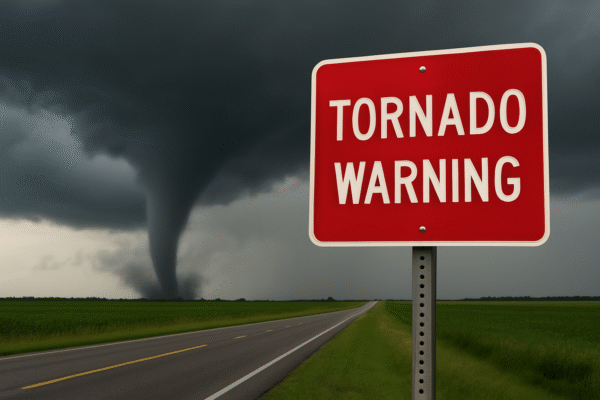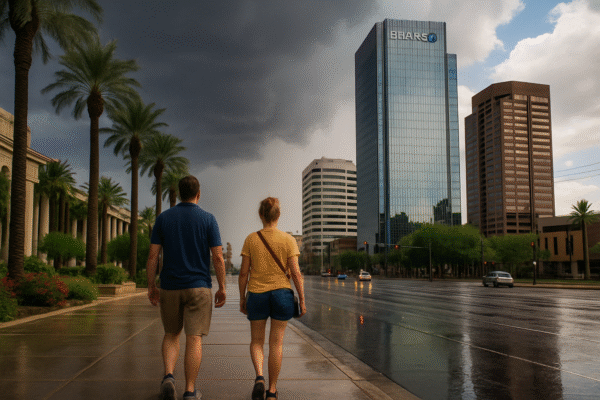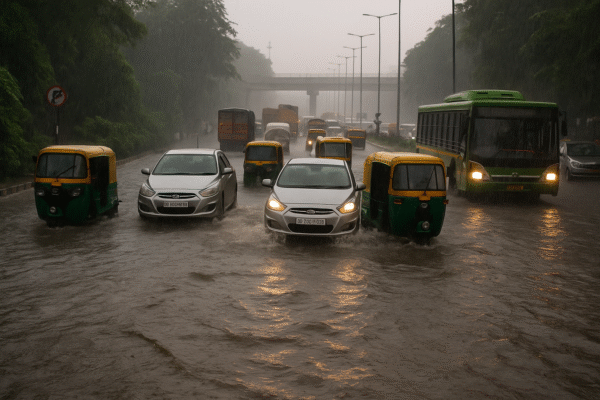IMD Issues Red Alert as Heavy Rainfall Paralyzes Delhi-NCR: Traffic Disruptions, Yamuna Flood Risk on the Rise
New Delhi, India – July 23, 2025:
Delhi and its surrounding National Capital Region (NCR) are grappling with severe weather conditions as the India Meteorological Department (IMD) has issued a red alert for the region following relentless monsoon showers. The downpour has led to widespread waterlogging, traffic gridlock, and heightened flood risk from the swelling Yamuna River.
Monsoon Mayhem: Streets Turn into Streams
The IMD has warned that moderate to heavy rainfall accompanied by gusty winds up to 40 km/h will continue through the week. The deluge, triggered by a low-pressure system over the Bay of Bengal, has brought normal life to a standstill across Delhi, Noida, Gurugram, Ghaziabad, and Faridabad.
Water has inundated key roadways including ITO, Lajpat Nagar, Mehrauli-Gurgaon Road, and Syama Prasad Mukherjee Marg, where long queues of stalled vehicles became a familiar sight. The Delhi Traffic Police issued real-time alerts urging drivers to avoid underpasses and low-lying routes, particularly around Chatta Rail Chowk and Lajpat Nagar Flyover.
Commuter Chaos and Public Transport Disruptions
The intense rainfall has exposed the city’s infrastructure vulnerabilities, with auto-rickshaws, buses, and private vehicles struggling to navigate submerged streets. Commuters took to social media to share visuals of submerged roads, stranded trucks, and waterlogged residential zones.
While the Delhi Metro provided a much-needed lifeline, it wasn’t completely immune to minor delays. In contrast, bus services were significantly delayed or rerouted, worsening the city’s daily travel woes.
Delhi Airport Operations Stable, Minor Flight Diversions Reported
Despite ground chaos, Indira Gandhi International (IGI) Airport remained operational. The Delhi International Airport Limited (DIAL) confirmed that while some flight diversions occurred due to low visibility and wind shear, major delays or cancellations were avoided. Passengers were advised to arrive early to factor in traffic congestion on routes to the airport.
Yamuna River Rising: Low-Lying Areas on Flood Alert
Beyond urban flooding, authorities are closely watching the Yamuna River, which has seen a sharp rise in water level due to intense upstream rainfall. The Hathnikund Barrage in Haryana has released over 50,000 cusecs of water—marking the highest discharge of the monsoon season so far.
The Delhi Disaster Management Authority (DDMA) has issued alerts for flood-prone zones such as Yamuna Bazar, Usmanpur, and Old Delhi’s low-lying belts, urging residents to remain on high alert and prepare for possible evacuations. Relief shelters are being prepped, and disaster response teams remain on standby.
Forecast Ahead: More Rain, Worsening Conditions Likely
According to IMD’s latest bulletin, heavy to very heavy rainfall is likely to persist until the weekend. Delhi remains under a red alert, while adjoining districts in Haryana, Uttar Pradesh, and Rajasthan are under orange and yellow alerts depending on localized intensity.
The monsoon trough, coupled with upper air cyclonic circulations, is expected to bring intermittent rain spells. Citizens are advised to monitor IMD’s official website and follow updates via the Rainfall Alert and Nowcast App (RAINA) for real-time alerts.
Government Advisories and Safety Measures
In response to worsening conditions, the Delhi government has issued public safety advisories emphasizing the following precautions:
- Avoid unnecessary travel during peak rainfall hours.
- Do not enter submerged roads or underpasses.
- Switch off electrical devices in waterlogged areas.
- Keep emergency kits and power backups ready in flood-prone homes.
- Check travel routes before heading to airports or railway stations.
The Delhi Traffic Police is actively posting rerouting updates on X (formerly Twitter), while the Municipal Corporation of Delhi (MCD) has deployed additional pumps to mitigate waterlogging in hotspots.
Citizen Response and Community Solidarity
Amid the deluge, citizens have demonstrated resilience. Local communities and NGOs have stepped up to assist elderly and disabled residents, distribute food packets, and help clear blocked drains.
Meanwhile, urban planners and civic bodies are facing renewed criticism over Delhi’s drainage system, highlighting the need for long-term flood mitigation and climate-resilient urban infrastructure.
Conclusion: Monsoon’s Wrath Demands Vigilance and Preparedness
As Delhi-NCR continues to battle this intense monsoon spell, the red alert serves as a stark reminder of the region’s climate vulnerability. With rain forecast to continue and flood threats mounting, both residents and authorities must work in tandem to minimize risks.
Travelers, commuters, and residents are urged to stay informed through official weather and traffic channels, and to prioritize safety over urgency. This monsoon may be far from over—but with caution, coordination, and community effort, Delhi can weather the storm.
For more travel news like this, keep reading Global Travel Wire


















